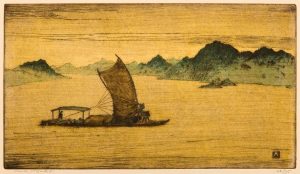Iori Yamamoto
The piano concerto is one of the most popular forms of music. The natural drama created between the contrast of the orchestra and piano, as well as the form’s tendency to facilitate memorable melodies and expressive moments, mean there are dozens of piano concertos with some claim to fame. However, one piece stands out, with distinctly un-Western influence. The Yellow River Piano Concerto (黄河协奏曲) was composed by several Chinese composers in the late 1960’s. The work is based on the Yellow River Cantata, an 8 movement cantata, which itself was based on a patriotic poem written during China’s war with Japan in the 1930’s. I listened to the 1970 recording of the premiere of the piece, as played by Yin Chengzong, one of the musicians who collaborated on the composition of the piece.
The first movement, entitled Prelude: The Song of the Yellow River Boatmen, shows the harsh waves of the mighty Yellow River with sweeping chromatic lines in the winds and timpani rolls. The conversatory back and forth between orchestra and piano depicts typical work-chants of the boatmen navigating the river, encouraging one another to hold firm and to not be afraid, as in the original canata. Overcoming the Yellow River represents the spirit and resilience of the Chinese people. This movement establishes the concerto’s reliance on the pentatonic scale, the almost cliché identifiable trait of Chinese music, in combination with tonal harmony.
The second movement is slow, and entitled Ode to the Yellow River. The inscription describes the movement as a trip down history, tracing China’s long and storied past. The movement begins with the slow and stately theme in the cellos. The piano then states the theme, with Rachmaninoff-esque piano writing that continues throughout the movement. The lyrical melody sings praise for the Yellow River. The movement ends with a triumphant quotation from the Chinese national anthem, the March of the Volunteers, with the highly recognizable trumpet fanfare from that piece.
The Wrath of the Yellow River, the third movement, begins with a Chinese flute playing an elaborated folk melody. The piano then enters, imitating a traditional zither, with the addition of glissando-like embellishments characteristic to those instruments. This peaceful section is said to represent the calm life of those living around the Yellow River. A sudden change to the minor mode depicts an enemy invasion. The following single note tremolo in the piano part is an imitation of traditional lute instruments. After an intense piano solo passage, the movement ends with more virtuosic writing for the piano.
Although The Yellow River Piano Concerto is not the most musically innovative, and not very profound or complicated, it is undeniably fun to listen to a romantic (and slightly cheesy) piano concerto dressed in Chinese musical devices.

Iori Yamamoto

